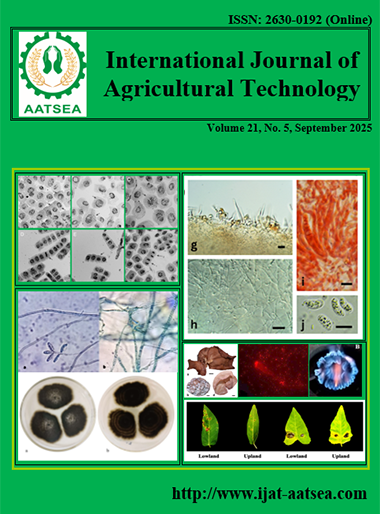Fungal community dynamics in vermicomposting systems: A metagenomic analysis.
Main Article Content
Abstract
The results indicated the highest species diversity in vermicompost, with a Shannon diversity index (D index) of 5.2645, encompassing a total of 55 fungal species. In contrast, the gut of Perionyx sp. 1 and the vermicomposting liquid exhibited a D index of 4.4563 (50 fungal species) and 2.3183 (24 fungal species), respectively. In terms of evenness, vermicompost achieved the highest score, with an evenness index (E index) of 0.9456. The Principal Coordinates Analysis (PCoA) diagram revealed overlapping fungal species among the three samples within the vermicomposting system, represented by PC1 and PC2, accounting for 75.07% and 15.14% of the variance, respectively. The analysis showed that the gut of Perionyx sp. 1 and vermicompost shared 25 species, while there were 9 shared species between the gut and the vermicomposting liquid. Conversely, the vermicompost and vermicomposting liquid exhibited only 7 common species. The overall similarity among the three samples in the vermicomposting system was limited to 4 fungal species: Aspergillus flavus, A. penicillioides, Candida tropicalis, and Nigrospora oryzae. Notably, C. tropicalis demonstrated the highest percentage of species richness, comprising 28.41%, while N. oryzae achieved the best scores in both vermicompost (0.31%) and vermicomposting liquid (3.43%).
Article Details

This work is licensed under a Creative Commons Attribution-NonCommercial-NoDerivatives 4.0 International License.
References
Aira, M., Domínguez, J. and Monroy, F. (2016). Microbial biomass governs enzyme activity decay during aging of vermicompost. Compost Science & Utilization, 24:178-184.
Arraktham, S., Tancho, A., Niamsup, P. and Rattanawaree, P. (2016). Isolation and identification of IAA-producing bacteria from earthworm intestines and vermicompost. International Journal of Agricultural Technology, 12:229-239.
Behjati, S. and Tarpey, P. S. (2013). What is next generation sequencing? Archives of Disease in Childhood Education and Practice Edition, 98:236-238.
Choa, L., Chen, Y. and Luo, X. (2019). Analysis of microbial diversity in vermicomposting systems and its impact on waste degradation. Environmental Microbiology, 21:1234-1247.
Edwards, C. A. and Arancon, N. Q. (2004). Vermiculture technology: Earthworms, organic wastes, and environmental management. Waste Management & Research, 22:147-160.
Frąc, M., Hannula, S. E., Bełka, M. and Jędryczka, M. (2015). Fungal biodiversity and their role in soil health. Frontiers in Microbiology, 6:114.
Gomes, N. C. M., Fagbola, O., Costa, R. and Smalla, K. (2021). Dynamics of fungal communities in compost and their influence on organic waste degradation. Applied Soil Ecology, 165: 103926.
Huang, D., Zhao, J., Wang, R. and Wang, Y. (2020). Comparative analysis of fungal communities and metabolic functions in different types of compost. Bioresource Technology, 314:123726.
Jiménez, D. J., Chaves-Moreno, D. and Van Elsas, J. D. (2017). Unveiling the metabolic potential of two compost microbial communities involved in organic matter degradation. Science of the Total Environment, 612:541-551.
Koo, J., Park, S. and Choi, W. (2018). Comparative study on fungal community structure in vermicomposting systems with different types of organic matter. Journal of Microbiological Methods, 154:35-43.
Lopez-Velasco, G., Tomas-Callejas, A., Sbodio, A. and Suslow, T. (2019). Identification of uncultured fungal communities in environmental samples using high-throughput sequencing technologies. Frontiers in Microbiology, 10:2879.
Lv, Z., Guo, X., Zhao, Y. and Cao, W. (2018). Earthworm gut microbiota modulates organic matter degradation in vermicompost systems. Ecological Engineering, 120:56-64.
Smith, D. L., Johnson, C. B. and Shapiro, J. W. (2020). Metagenomics and taxonomy: New tools to understand microbial diversity in composts. Journal of Applied Microbiology, 129:881-892.
Sripan, S. (2016). The role of fungi in soil nutrient cycling and its implications for agriculture. Soil Biology Journal, 12:44-52.
Tancho, A. (2013). Textbook in natural farming: principles, concepts & appropriate techniques in tropics. Pathum Thani: National Science and Technology Development Agency.
Wang, H., Qian, W., Wang, J. and Huang, C. (2019). Microbial community shifts in vermicomposting systems and their effects on organic matter degradation. Compost Science & Utilization, 27:232-240.
Walia, S. S. and Kaur, T. (2024). Earthworms and Vermicomposting: Species, Procedures, and Crop Application. Springer Singapore. Available from https://doi.org/10.1007/978-981-99-8953-9
Yadav, P., Khillare, P. and Kumar, S. (2019). The role of Candida tropicalis in organic waste degradation during vermicomposting. Biocatalysis and Agricultural Biotechnology, 17:320-328.
Zhang, Y., Gao, P., Liu, X. and Zhang, J. (2019). Diversity and functional role of fungal communities in organic matter decomposition in composting systems. Environmental Science and Pollution Research, 26:22406-22418.


